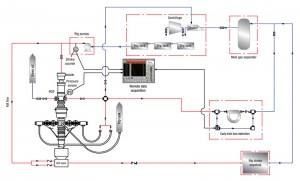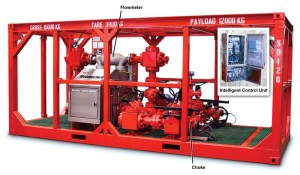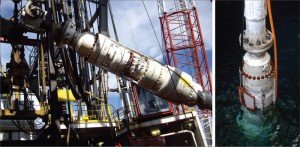Safe drilling operations come full circle
Closed-loop system provides real-time, accurate data for proactive management of downhole pressures
By Brian Grayson, Weatherford International

Although securing safe working conditions and creating efficient operating processes may imply laborious efforts and cumbersome equipment, Weatherford International’s approach leverages a fundamental aspect of all drilling operations – the mud system. Fluids in and out of the wellbore provide valuable information about downhole conditions, which leads to safe and efficient operations.
Common oilfield technologies, such as rotating control devices (RCDs), mass flow meters, automated drilling chokes and downhole isolation valves, individually provide incremental safety and efficiency in downhole operations. When combined to work conjunctively, the tools can create a closed mud-return system that captures and redirects the free flow of drilling fluids, cuttings and hydrocarbons from the wellbore annulus. Closing this loop establishes a contained circuit of incompressible drilling fluid.
When an intelligent control unit (ICU) is added to the closed-loop configuration, the result is a self-contained system capable of detecting minute downhole pressure and volume changes.
The Microflux system helps the mud system to become a highly sensitive instrument to implement proactive managed pressure drilling (MPD) strategies.
Closing the loop on risks and hazards
A kick during drilling and completion operations poses a major risk to rig personnel, the environment and the equipment. That risk can be exacerbated by inadequate downhole data.
With a closed-loop system, kicks and losses are more readily and accurately diagnosed. This is a significant advantage given that slow detection or a misdiagnosis can jeopardize the safety of personnel and the viability of drilling operations. A slow or incorrect response can also inflict irreparable damage to the environment and cost millions of dollars in nonproductive time (NPT).

The capability of monitoring, detecting and quickly reacting to pressure changes in the standpipe and at the surface enables the downhole pressure profile to be proactively managed and manipulated. More control helps the operator and driller to navigate safely and successfully through known and unknown hazards.
To ensure the most accurate and expeditious response, more downhole knowledge and control is a must, especially as drilling reach extends to greater depths, higher temperatures and pressures, and more extreme locales.
Early detection of wellbore pressure fluctuations can have particularly significant impacts on deepwater operations, where it is not uncommon to encounter high temperatures and high pressures or formations bearing H2S. In these operations, drilling windows are typically narrower and more difficult to drill, and the rig rate constitutes a significant expenditure.
Acquiring real-time data at the surface yields a better understanding of downhole pressure and how the formation and wellbore are responding to the drilling program. The speed and effectiveness of pressure management are enhanced for both conventional mitigation methods (i.e., mud weight and chemistries and BOP procedures) and MPD methodologies made possible by the closed-loop system.
Controlling equipment with instrumentation
Proactive pressure management via the fluid system starts with an RCD placed above the BOP to close the circulating fluid loop. The RCD’s elastomeric sealing elements and bearing assembly provide a pressure-tight barrier between the wellhead and the drill string. This barrier eliminates open-to-the-atmosphere mud returns to create the closed-loop system. With the RCD in place, drilling fluids, cuttings and hydrocarbons are safely circulated away from the personnel on the rig floor.
A variety of RCDs have been developed to work with different pressures, temperatures and wellhead diameters. Weatherford recently developed the first marine RCD for riser applications on floating rigs, which is also the first RCD to receive API certification. It addresses deepwater requirements for installation and maintenance and accounts for heave compensation in the riser.

Another key element of the closed-loop system consists of standard pressure sensors and mass flow meters to acquire wellbore mass balance information. These meters measure mass flow past a fixed point per unit of time. The closed-loop system denotes minute changes in bottomhole pressures at the surface within seconds, while volume variations of only gallons can be detected almost immediately.
Adding an annular choke manifold to this scalable closed-loop system marks a shift to pressure management using an MPD approach. The choke enables manipulation of backpressure, which provides dynamic control of the wellbore pressure and flow.
An ICU completes the equipment circle for the closed-loop system. This control unit houses the necessary data to measure and analyze physical properties and to react to adverse well events. The ICU uses proprietary algorithms to identify and relay the slightest downhole change and allows the engineer to distinguish between different events, such as ballooning, breathing, influxes and losses. In automated mode, the ICU controls the MPD chokes to regulate backpressure as needed. If, for instance, a small influx is detected, applying backpressure can minimize the influx to small volumes and allow the gas to safely circulate out of the system.
The integration of instruments and software enables automation of the system and the acquisition of real-time data. In difficult wellbore environments, this feature proactively identifies and manages influxes and losses for potentially faster responses to help retain control. The result is safer operating conditions. Additionally, mud weights can be optimized to improve drilling efficiencies and lower fluid costs.
The accuracy and immediacy of the data provides a high degree of insight into what’s happening downhole and improves the options to respond with more flexibility than simply weighting the mud system. On a fixed rig, the closed-loop system detected kicks at just 0.25 bbl of influx. On a floating drilling unit, where vessel heave movement introduced a 25 bbl/min peak-to-peak variation, a kick was detected at less than 3-bbl influx.
Because the majority of well control incidents occur during tripping, a downhole isolation valve (DIV) is commonly employed in closed-loop operations. The DIV protects against swabbing while pulling out of the hole and can be installed as a permanent or retrievable component to selectively isolate the wellbore. The valve is opened or closed as needed to enable tripping at conventional speeds. Maintaining tripping speed helps to prevent delays that can aggravate well control events and cause excessive NPT.
Data flow in real time
Avoiding trouble rather than mitigating causes of NPT and well control issues is a cost-effective strategy, especially considering the expenditures associated with offshore operations.
Offshore Egypt
HPHT conditions and wellbore ballooning in a tight operational window led some to question the economic viability of a field offshore Egypt. Several attempts to drill offset wells in this field were unsuccessful as a result of kicks and losses. Any sign of loss or gain was treated with caution because the potential consequences of a gas influx and subsequent expansion at surface could have resulted in a well control incident. Pore pressure ranged from approximately 17.6 ppg to 18.4 ppg, and the fracture gradient ranged from approximately 18.0 ppg to 18.6 ppg.
To continue with the drilling campaign, the operator revised its approach and employed a closed-loop system. During the operator’s first application, the closed-loop system detected kicks and losses with a semi-automated choke, enabling the necessary pressure management.
The operator’s second application used the fully automated capabilities of the system. The MPD approach enabled the operator to use a statically underbalanced mud weight and adjust annular backpressure at the surface to create a virtual mud weight. Adding or releasing annular surface pressure on the closed-loop system resulted in an almost immediate response in bottomhole pressure.
The 10 5/8 in. x 12 1/4 in. and 8 1/2 in. hole sections were successfully drilled to total depth (TD). In addition to helping reach the targeted casing points, the closed-loop system was used to fingerprint wellbore ballooning and breathing during connections.
Previously used drilling methods misdiagnosed these incidents as kicks and losses. However, the accuracy of the data obtained with the closed-loop system enabled the operator to continue the drilling campaign with a more effective and safer strategy.
Offshore India
The complex geology in the Asia Pacific region is prone to tectonic activity, heavily faulted and folded strata, lost circulation zones and uncontrolled mud flows. The conglomerates, igneous and carbonates prevalent in this region present many drilling challenges. MPD is the preferred methodology to mitigate severe circulation losses associated with fractured carbonate formations. More than 100 MPD wells have been drilled since 2005. Wells that experience kick/loss and near- or total-loss scenarios are now being drilled safely and efficiently.
An MPD application offshore India significantly reduced time lost to downhole problems to one day. Mitigation of similar problems in previous offset wells averaged 10 days. The significant reduction in troubleshooting was achieved by reducing kick/loss cycles and other flat time associated with narrow pore pressure/fracture gradient. Time was also saved when more control of the mud weight led to an increase in ROP.
Fractured carbonate reservoirs offshore North Africa are being drilled using MPD methodologies. In one well, low bottomhole pressure and H2S gas contributed to mud losses of 1,400 bbl/hr and a low ROP. MPD methods eliminated expensive mud losses, prevented sour gas from reaching the surface and increased the ROP from 40 ft/day to 220 ft/day (12 meters/day to 67 meters/day).
Onshore shale plays
Although the daily rig rate is not as high and depths are shallower, drilling objectives for land operations mirror those set for offshore campaigns – safely reach the planned depth, within budget, and find enough producible reserves for adequate return on investment.
The shale gas plays in Northwest Louisiana and East Texas have seen wells drilled into formations with low permeability and high porosity. These characteristics typically create over-pressured zones that have obvious drilling concerns. The unconventional gas target known as the Haynesville shale requires a horizontal step-out in excess of 10,000 ft MD. A recent successful drilling strategy employed MPD techniques to target this Upper Jurassic formation that contains significant microfracturing.
RCDs without a flow meter or software have been used as a means to apply backpressure on an as-needed basis. Wells typically employed 16.5-ppg oil-based mud (OBM) when drilling out the 7-in. casing shoe and making 6 1/8 -in. hole. With the first deployment of the closed-loop system, the shoe exited with just 14.8-ppg OBM. The intent was to hold that mud weight through the build section and horizontal to TD.
Better downhole visibility and control in gas-prone sections resulted in several improvements. By enabling the use of a lighter mud weight, the rate of penetration (ROP) increased from about 15 ft/hr to as high as 60 ft/hr. Improved drilling rates and less NPT associated with well control cut drilling time in half. The well reached TD in 16 days as opposed to the planned 31 days. This time reduction was attributed to an increase in the ROP as a result of drilling with a lower mud weight and detection/depletion of microfractures in a controlled and safe manner.
The Barnett Shale in East Texas also yields significant gas reserves. MPD has reliably identified high-pressure kicks, allowing the wells to be safely shut in. In one instance, an overbalanced well lost 200 psi when the pumps were stopped. When flow declined as expected and then unexpectedly began to increase, the well shut in.
In the three minutes that transpired from stopping the pump to shut in, the well gave a 35-bbl kick. The ability to immediately see the flow and to expeditiously react by closing the BOP prevented the kick from becoming a major well control event – an all too frequent outcome in the area.
Beyond the horizon
Although drilling objectives are being pushed further and into more complex conditions, they are attainable without putting personnel at risk or jeopardizing the environment. Continual development of enabling technologies and processes, including both the closed-loop system and MPD methodologies, has put previously inaccessible reserves within reach.
A subsea RCD close to commercialization will be installed above the subsea BOP and enable riserless drilling while enhancing operational safety. A sub-based continuous flow system in development will reduce wellbore instability issues and enhance HSE. More sophisticated monitoring, analysis and management software will further extend the capabilities and applications of the technology.
Access to more accurate downhole data and the ability to manage drilling pressures will allow operators to not only see beyond the horizon but to produce it.
Microflux is a registered trademark of Weatherford International.




